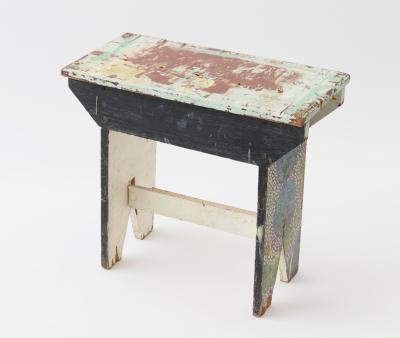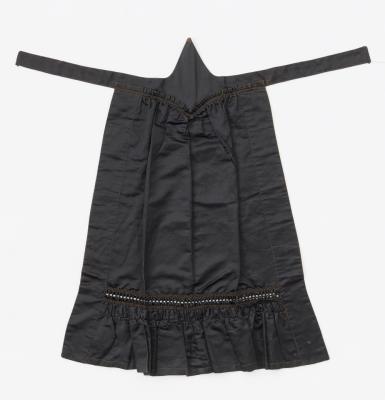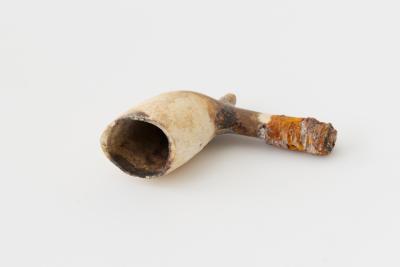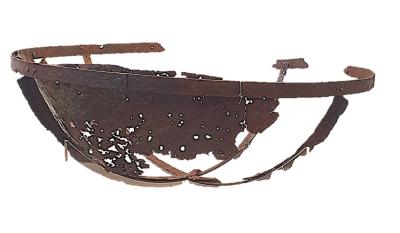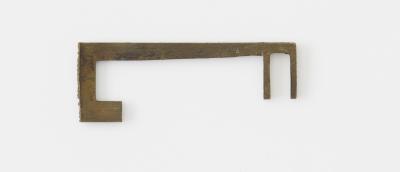PAINTED TABLE
1952 - 1979Large, low, rectangular, wooden coffee table with a painting of a bush scene painted on the top. Table is made from dark wood, with a large rectangular top, and four thin, cylindrical legs, that come away from the table at an angle, all with gold coloured metal feet. The table top is a painted scene of bushland, with several large, eucalyptus trees in the foreground, and dense bushland leading to low mountains beneath a blue sky in the background. In the lower right-hand corner, the painting is signed in cursive text, 'Revel Cooper'. The painting has a piece of clear glass over the top.
Donated by the daughter of a former Prison Warder, Mervyn Victor Jackson, who received this table as a retirement gift in the 1960s or 1970s.
Made and decorated at Fremantle Prison.
Details
Details
Revel Cooper
Mervyn Victor Jackson was trained as a builder, however he worked as a Prison Warder at Fremantle Prison after the Depression hit. He and his young family moved into No. 2 The Terrace in the mid-1930s, where he paid 17 shillings from his weekly salary (which was 3 pounds and a few shillings) in rent. Several years later he was transferred to Barton's Mill. His previous training as a builder saw him working on the construction of the Barton's Mill Prison complex, where he worked for five years, before returning to Fremantle Prison. The family then lived at 9 Holsworth Street. Jackson had a reputation for showing kindness to the prisoners, and did not tolerate abuses of power among the staff. He was offered the position of Chief Warder but declined, not wanting the additional pressures that went with the job. He retired in either the 1960s or 1970s, and was presented with this decorated table as a farewell gift. There was also a dance thrown in his honour, held at a hall near the Esplanade Hotel.
Artist Revel Ronald Cooper was born of Nyungar descent at Katanning, Western Australia, in 1934. As a young boy Cooper was declared a ward of the state and placed in the Carrolup Mission settlement. Amid conditions of poverty and degradation, the school’s headmaster, Noel White, established educational programs in art and music in 1945. The Mission is best known for fostering the Carrolup style of painting, a style that became famous in Australia and overseas, with many pupils going on to become established artists. The Carrolup Mission was closed by the Department of Native Affairs in 1951, and unfortunately many former students of the school later found themselves behind bars in Fremantle Prison, where the Carrolup art style became a common theme in prisoner art.
Revel’s own work first appeared in Child Artists of the Australian Bush, written by Dame Mary Durack Miller in 1952. Noel White intended that the training provided at Carrolup would serve a vocational role and Cooper was employed for a short period by J. Gibbney & Son Pty Ltd, who were commercial artists in Perth. When Carrolup Mission closed, Cooper worked locally as a farm labourer and as a railway fettler.
In November 1952 Cooper was convicted of manslaughter and sentenced to four years’ imprisonment. Cooper subsequently served several prison sentences in both Western Australia and Victoria. Despite these terms of incarceration, Cooper still succeeded in forging a career as an artist. In the mid-1950s he was employed briefly at Bill Onus’ Aboriginal Enterprise Novelties, where he became a role model for the young aspiring artist Lin Onus, and a formative influence on later generations of Nyungar artists. With help from art collector James Davidson and the Victorian Aborigines Advancement League, Cooper exhibited regularly during the 1960s in Victoria and elsewhere, gaining recognition for his landscapes and corroboree scenes. During a term in Fremantle Prison, Cooper undertook several art commissions, including illustrations for the second edition of Mary Durack’s book Yagan of the Bibbulmun, published in1976, and images of the Stations of the Cross for the Sacred Heart Church, Mount Barker, in Western Australia.
With emerging Aboriginal self-determination, Cooper assumed a new cultural voice. While imprisoned in Geelong, Victoria, he wrote an article, To Regain Our Pride, for the July-September 1968 issue of the Aboriginal Quarterly. In an interview for a documentary, The Broken Covenant, broadcast posthumously by Australian Broadcasting Corporation television on 1 September 1983, he recalled his experiences with discrimination and injustice, and, in a passionate affirmation of his Aboriginality, attacked the materialism of a ‘white’ and ‘machine’ world.
Cooper’s struggle with alcoholism, and his itinerant lifestyle contributed to both his achievements and the tragedy of his life. Around April of 1983 he died from head injuries sustained when he was attacked with a heavy instrument. His body was found on 28 December 1985 at Buxton, after Matthew DE Carteret confessed to his murder. Cooper was buried on 30 January 1987 in the Catholic section of the Fawkner cemetery.
Cooper is regarded as a leading figure of a distinctive Nyungar landscape tradition, which is the heritage of Carrolup. His work is represented in the Berndt Museum of Anthropology at the University of Western Australia, the Art Gallery of Western Australia, Fremantle Prison, the Fremantle Hospital and the Holmes à Court collection.



